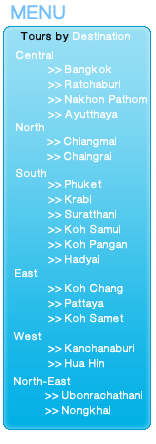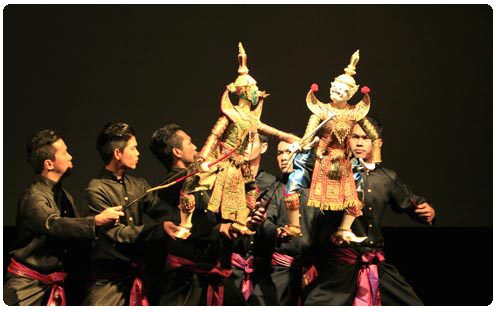Introducing Thai Theatrical Puppetry
The thratrical puppetry is unique smong the various forms of puppetry in that each puppet
represents a character taken from the traditional Thai theater. There are three types of
traditional Thai theatrical performances, all of which are stylized, with dancing, singing and music
comparable in complexity with the European opera-ballet of the 18th century French royal
court at Versailles. The most sophisticated od these is khon, which performs only the ramakian
(the Thai versoin of the Indian epic, Ramayana); the less ssophisticated is lakhon, performs all
other classics of Thai drama; and the least sophisticated is likey, which performs common
drames, Thai theatrical puppetry is also unique in that each puppet requires the synchronised
efforts of three puppeteers is its manipulation, all of whom appear on stage with the puppet
and each of whom is khon, lakhon or likay performer in his or her own right. The puppets, in
short, perform khon, lakhon or likay on stage with the puppeteers, where the name 'theatrical
puppetry'.
The Traditional Thai Puppet Theater Company is the authoritative guardian of this dying art
form: the directors and senior members of the troupe are direct artistic seccessors of the
founder of Thai theatrical puppetry. Performances are as unique as they are authentic
Performance at the Traditional Thai Puppet Theater are s showcase for Thailand 's cultural
heritage and reflect the undtinting efforts of the troupe to preserve and perpetuate this exotic
art form.
Createtion
Thai theatritic puppetry was invented in 1901 by the legendary khon dancer, Krae saptawanit.
Maestro Krae was inspried to create puppets when he saw the grace and ingenuity of the royal
puppets and of the puppetsof the deputy king 's palace. The first puppet the created was of the
charactor he portrayed on the khon stage, the principal male character. This puppet stood two
feet tall. However, he found that in order to make its movements realistic and approximate the
movements of khon dances, he needed the help of his theatrical colleagues. The meahanisms
and the techniques were quickly perfected, and a new kind of puppetry was invented.
Early Popularity
After creating his first puppet and perfecting the mechanism and the technques for
manipulating it, Maestro Krae Saptawanit made more puppets and soon founded a troupe of
puppeteers that could perform khon with puppets. Performances were frequent and popula.
The principal characters were each manipulated by three puppeteers, and the rest were
manipulated by two puppeteers, or even by one puppeteer, depending on how mach
movement was required. In the early decades of the theatrical puppetry, the puppeteers stood
behind a screen and manipulated the puppets above it, so the viewers could only see the
puppets but not the puppeteers. There were male and female puppeteers, but there was no
davision of labor.
The Name
Thai aristocrats and theater people who saw Maestro Krae Saptawanit 's performances called
his invent Hun Lakorn Lek -'hun' means model or puppet; 'lakorn' refers to staged drama;
and 'lek' means amall because the puppets were smaller than the characters of Thai staged
dramas. The original Thai name is sometimes tranlated as 'Small Theatrical Puppetry',which is
misleading in European languages as western puppets are always small, and to add the
adjective ' small' to puppets would suggest that the puppets are minuscule. In fact, the so-
called 'Small Theatrical Puppets' first created by Maestro Krae Saptawanit have grown:they
now stand at three feet. The word 'small' has been appropriately dropped from the English
name.




